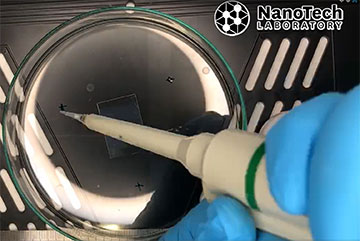
The experimental setup for the sensor undergoing the novel processing technique. [Image: Huang and Nasiri]
Scientists in Australia have reportedly shown how to improve the sensitivity of nanoparticle-based ultraviolet sensors by exposing zinc oxide nanoparticles to vinegar fumes at room temperature (Small, doi: 10.1002/smll.202402558). They say that their findings could enable cheap, efficient, high-performance sensors suited to wearable applications, arguing that the techniques involved could also be applied to other nanostructured devices.
Improving contact
Sensors made from very porous networks of nanoparticles can achieve high sensitivities thanks to elevated ratios of surface area to volume. But they also have a weak spot―the fact that the flow of charge carriers needed to register a detection is often impeded by poor contact between nanoparticles.
One way around this is to introduce thermal annealing―subjecting porous nanoparticle films to high temperatures to enhance the interface between nanoparticles. But this heating increases the cost of fabrication and is unsuited to the kinds of polymer and electrodes used in modern wearable devices.
An alternative approach is to force nanoparticles closer together by immersing them in a liquid and exposing them to the capillary effect. The liquid flows into the tiny gaps between nanoparticles, and then as it evaporates, the nanoparticles are pulled together at their extremities to form distinct islands in the material. However, this process also changes the shape of the nanoparticle network, making it unsuited to some applications.
Watery vinegar vapor
In the latest work, Noushin Nasiri and colleagues at Macquarie University in Sydney instead exploit the capillary force brought about by vapor, which has a minimal effect on the network’s shape. Specifically, they used a vapor featuring acetic acid, since this can dissolve zinc oxide nanoparticles. They found that simply using water vapor did not yield enough force, while pure acetic acid produced too much and destroyed the nanoparticle network. Their results showed that a compromise between the two―a vapor of watery vinegar―was just right.
The researchers’ fabrication technique starts by forcing a zinc solution through a nozzle, burning it and then intercepting the resultant fine mist of zinc oxide nanoparticles with a water-cooled platinum substrate. This causes the nanoparticles to form a very porous film, which is then transferred to a room-temperature petri dish and exposed to vapor molecules of acetic acid for up to 20 minutes. The film is then placed in a 130°C oven for drying.
They found that the optimum exposure was about 15 minutes, ―at which point the film was over 100,000 times more responsive to ultraviolet light than the unexposed film.
The researchers gauged the light-sensing ability of the nanoparticle film by varying its exposure to the acetic acid and comparing it to one film with no exposure and another subjected to thermal annealing at 300°C for 12 hours. They found that the optimum exposure was about 15 minutes, ―at which point the film was over 100,000 times more responsive to ultraviolet light than the unexposed film and at least 5,000 times more responsive than the thermally annealed one. The team also found that the vapor-treated films had very low dark currents.
Nasiri and colleagues recorded an extensive set of images using electron microscopes, establishing that prolonged exposure to the vapor changes the type of voids in the porous nanoparticle networks. Rather than existing on both the meso and macro scale, as is the case in untreated films, the voids become increasingly concentrated on larger scales, with denser filament-like structures surrounding them. They say that this results both in better electrical conductivity and superior light detection.
Scaling up
The researchers argue that their work “demonstrates a remarkable reduction in time and energy,” given the many hours and high temperatures needed for thermal annealing. They also reckon that the work “paves the way” for nanoparticle-based sensing technology that can be used in nanoelectronics and wearable devices, which must be flexible and consume little power. The team says that the fabrication process could be scaled up commercially, with the zinc oxide sensors laid out on a rolling plate and then moved through a closed volume containing the acid vapor.
Nasiri and coworkers add that the same technique could yield other kinds of nanostructured devices, such as sensors for gas or light as well as solar cells, explaining that this could be achieved by varying the starting materials and type of substrate. But they say that more work needs to be done to ensure the uniformity of nanoparticle joins throughout a film, and to then integrate nanostructures into commercial devices.
